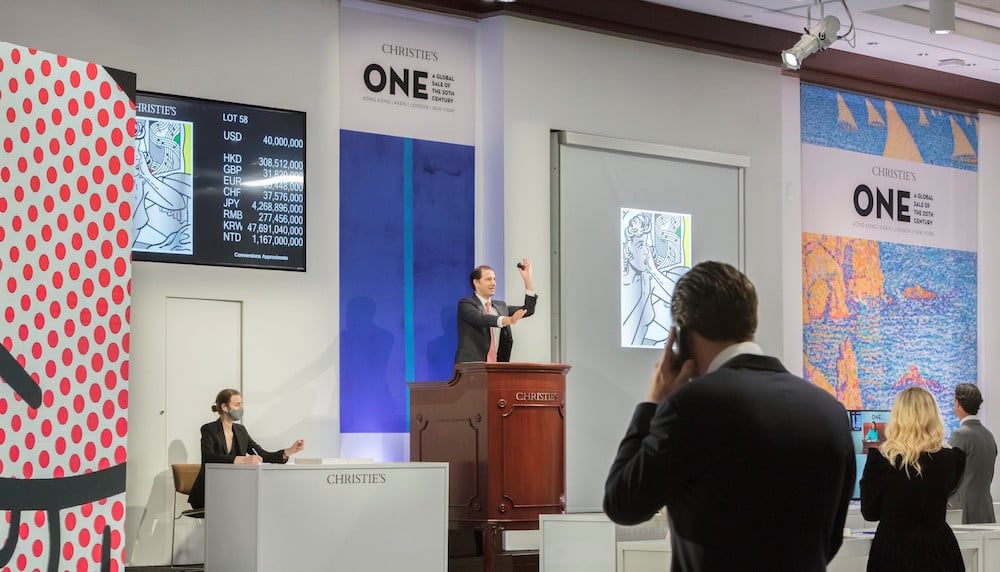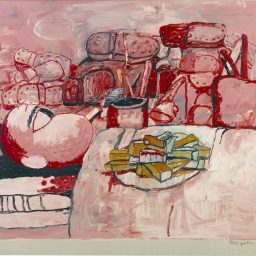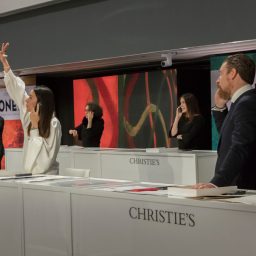Like so much else that has been radically altered in the face of the global health situation, Sotheby’s, Christie’s, and Phillips had to adapt fast in order to roll out viable platforms for their marquee spring sales, which are typically held in New York in May and London in June. The result was the first-ever hybrid online-in person livestreamed evening sales, held in late June and July, which sought to encourage uber-wealthy buyers to bid on seven- and eight-figure trophy artworks from the comfort of their own homes.
So, how did it go? Even with the expected technical glitches, the houses turned in impressive performances, buttressed by hefty third-party and in-house guarantees. But the numbers are still far behind pre-shutdown levels. In all, the three major evening sales generated a combined $825.2 million—a decrease of almost 50 percent from last year’s $1.7 billion New York evening sale total in May 2019.
Here are some parting thoughts on the past two weeks of hybrid sales.
Biggest Winner: Christie’s
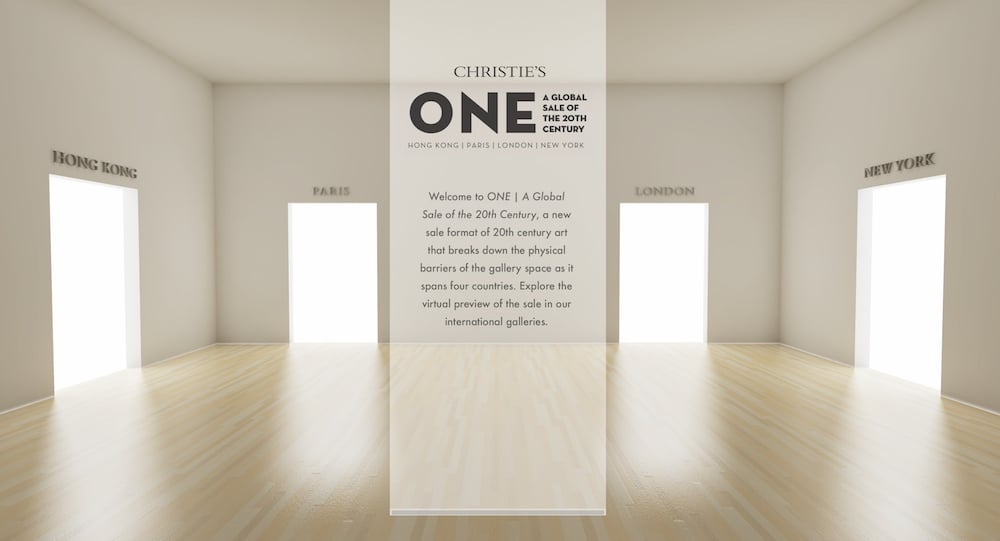
Image courtesy of Christie’s.
Depending on what time zone you were in, Christie’s major event this year—a July 10 sale titled “ONE,” which combined top Impressionist and Modern works with postwar and contemporary art—technically wasn’t an evening sale. (It started at around 9 a.m. New York time/9 p.m. in Hong Kong.) But the four-hour, four-city livestreamed marathon did pull in the highest total of the three major houses, generating an impressive $421 million and brushing up against the high end of the $332.4 million to $444 million estimate. (Final prices include buyers’ premium; pre-sale estimates do not.) Still, that figure trails Christie’s May 2019 combined New York evening sale total, which came in at $937.9 million.
Sotheby’s came in second place with a $363.2 million for a three-part evening sale on June 29 that included works from the collection of the late collector and philanthropist Ginny Williams, postwar and contemporary art, and a selection of Impressionist and Latin American art. (That total was down almost 50 percent from May 2019.) Perennial third-place finisher Phillips pulled off a “white-glove” sale on July 2 that netted a modest $41.2 million, a dip of almost 60 percent from May 2019.
Notably, these figures all represent gross totals and don’t factor in any financing deals, third-party guarantees, or other arrangements that auction houses often use to secure high-profile material and that sometimes dip into their profit margins.
Priciest Work: Francis Bacon’s Triptych Inspired by the Oresteia of Aeschylus (1981)
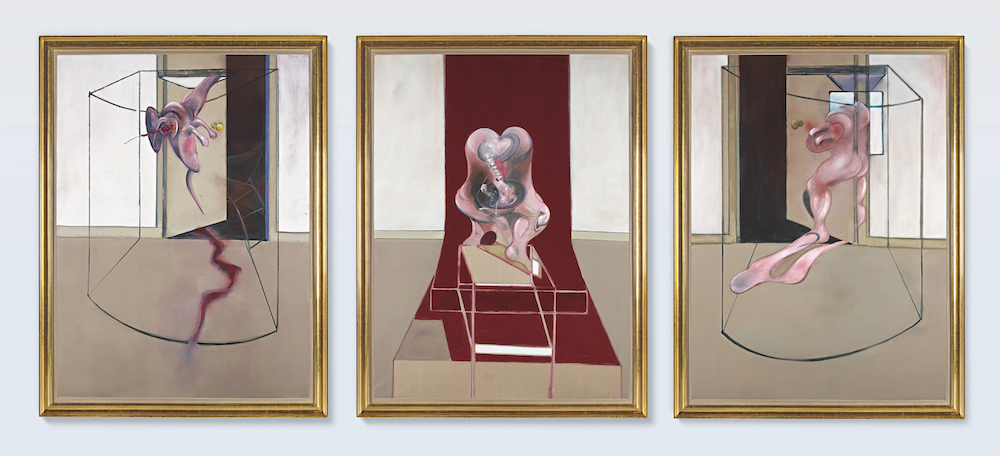
Francis Bacon, Triptych Inspired by the Oresteia of Aeschylus (1981). Image courtesy of Sotheby’s
The most expensive lot of the sale series was Francis Bacon’s Triptych Inspired by the Oresteia of Aeschylus (1981), which fetched $84.6 million with fees, just over the pre-sale high estimate of $80 million. (The hammer price fell under estimate, at $74 million.) It was offered by a foundation tied to Norwegian billionaire Hans Rasmus Astrup. The work is now the third most expensive Bacon ever sold at auction, behind Three Studies of Lucian Freud, which sold for $142.4 million at one of the market’s recent peaks in 2013, and a 1976 triptych, which sold for $86.3 million in 2008.
Grace Under (Digital) Pressure: Oliver Barker
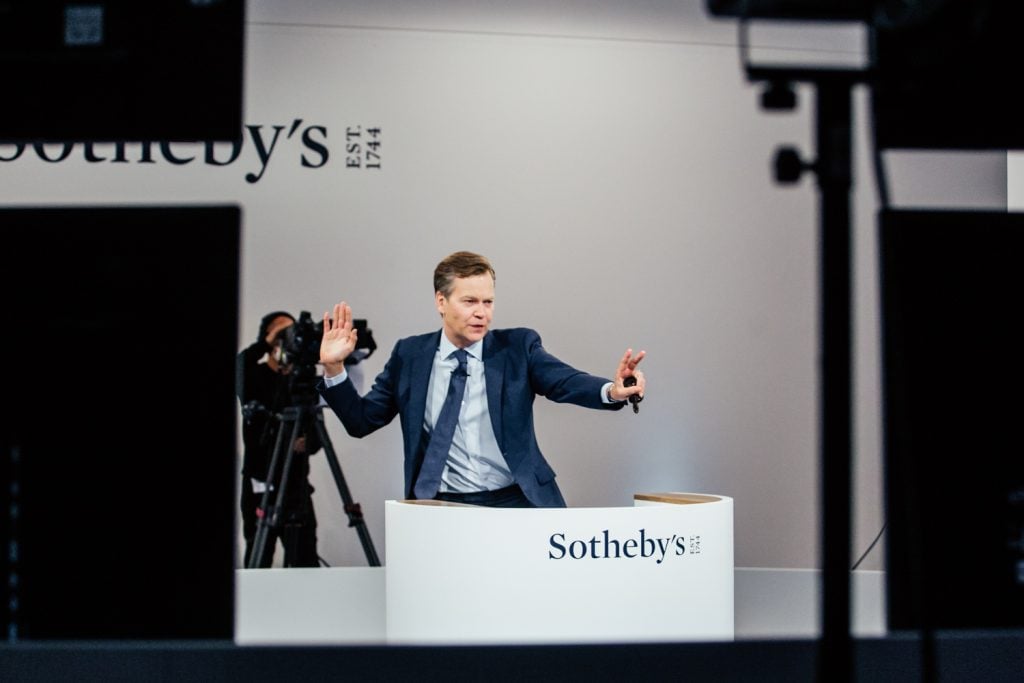
Oliver Barker in action during Sotheby’s livestreamed sale. Photo: Sotheby’s.
Auctioneer Oliver Barker deserves kudos for orchestrating a seamless evening. There were virtually no instances of mishaps or confusion and the only extended pauses appeared to occur—as is typical for an event like this—when a buyer was struggling to make up his or her mind. But an extremely odd pattern began to emerge during the competition for the megawatt Bacon, which Barker opened for bidding at $48 million. As it made its way up to $60 million, a bid placed by Grégoire Billault, head of the contemporary art department, was suddenly bested by a mysterious online bidder from China who raised the price by $100,000—an extremely small increment considering the hefty price.
Billault’s bidder then leapt a full $900,000 further, to $61 million. The cat-and-mouse bidding war carried on, with tiny increments battling large ones, for a total of $14 million, until Billault’s big-bidding client finally grasped the prize. As it turns out, the explanation for the situation is quite straightforward, but indicative of the novelty of the event: bidders operating through the online platform can only submit a maximum increase of $100,000. Through it all, Barker remained unfazed.
Most Flipped: Amoako Boafo
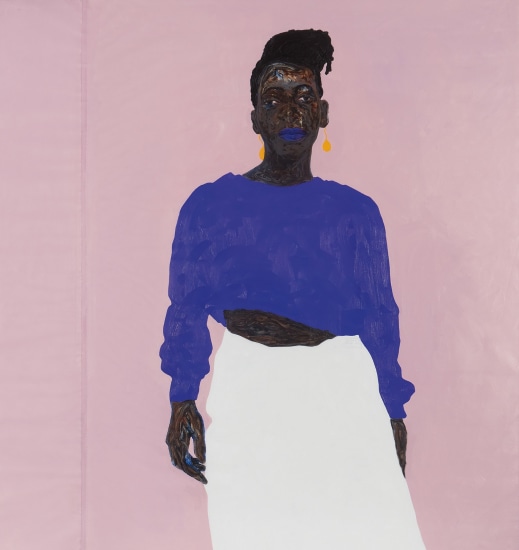
Amoako Boafo, Joy in Purple (2019). Photo courtesy Phillips.
The global shutdown threatened to halt the momentum of up-and-coming artists making moves in the first few months of 2020, the most promising of whom were set to see their demand snowball and the prices steadily increase. But there will be no stifling the red-hot hype behind Amoako Boafo, the young Ghanaian-born, Vienna-based artist who paints stylish, bold portraits of his friends with his own paint-dipped fingers in lieu of brushes. After one of his works sold for $881,000 at auction in February, weeks before the global lockdown took hold, speculators spent quarantine swapping Boafos for higher and higher price tags—so frequently, in fact, that when Joy in Purple came to the block at Phillips, it had already changed hands three times in the 12 months since it left the studio. That didn’t scare off bidders, however. Demand was so fierce that it sold for $668,000 over a $70,000 high estimate.
Most Auspicious Debut: Robert Nava
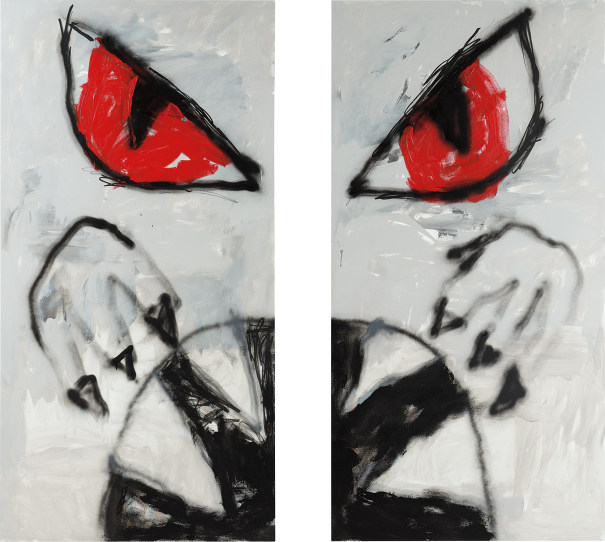
Robert Nava, The Tunnel (2019). Photo courtesy Phillips.
Back in March, Sorry We’re Closed gave its Armory Show booth over to the young artist Robert Nava. Nava is the new bad boy of Bad Painting, a Brooklyn-based rising star who says his hastily made, emotionally raw canvases are “carefully done wrong.” But Nava’s market is carefully done right. There was a long waiting list for the $25,000-to-$35,000 paintings at the Armory booth, and it would have presumably been the same situation the next month at the Dallas Art Fair, had the event gone forward. Still, the buzz around the work was enough to push one collector to consign a painting to Phillips for its July 2 sale—the first Nava ever to come to auction. First shown at Sorry We’re Closed in Brussels in 2019, The Tunnel is a raw portrait of a beast with red eyes, and bidding pushed it way past its $60,000 high estimate to hit $162,500.
Broadest Appetite (and Biggest Return): Matthew Wong’s The Realm of Appearances (2018)
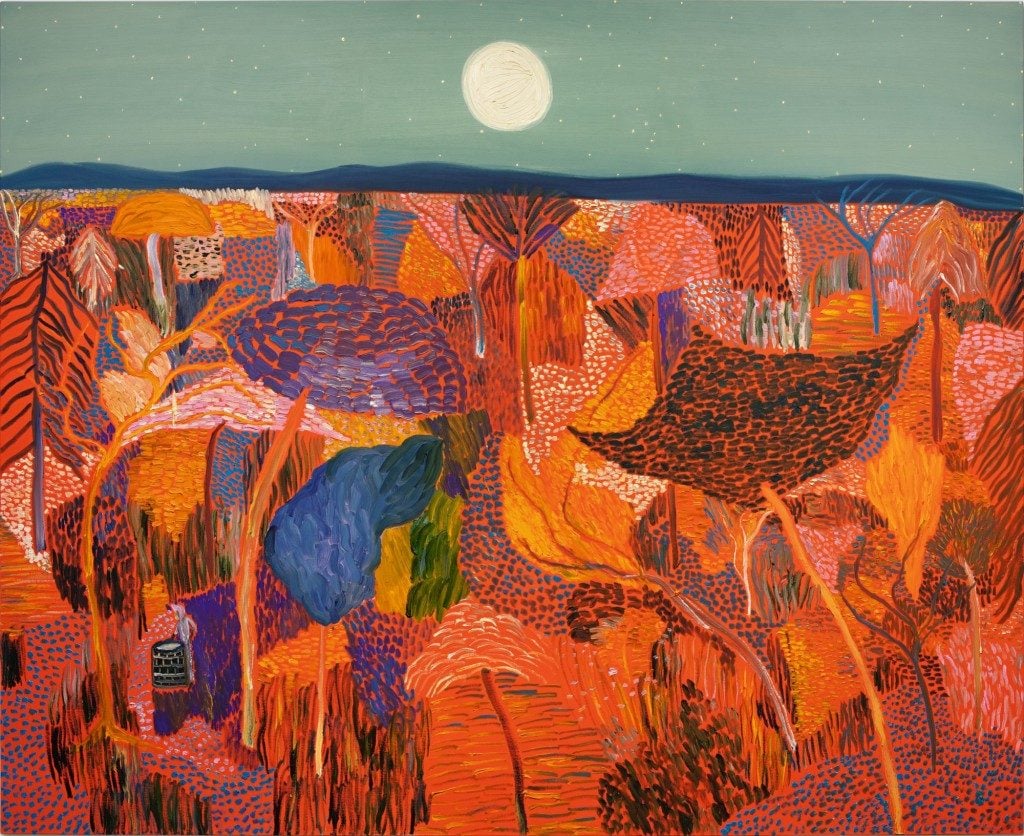
Matthew Wong, The Realm of Appearances (2018). Image courtesy Sotheby’s.
The market for Matthew Wong, the talented Canadian painter who died by suicide at age 35 in October, has ignited in a way that feels more than a little bit ghoulish. Five works by Wong were offered in the past two weeks; all of them more than tripled their high estimates. The record-setting work, The Realm of Appearances (2018), sold at Sotheby’s on June 29 and was reportedly consigned by former Sotheby’s executive Allan Schwartzman. It soared to $1.8 million on a $60,000 to $80,000 estimate. According to Sotheby’s, a whopping 58 bidders registered to compete for the work. It was originally purchased from the artist’s debut exhibition at Karma gallery two years ago for $22,000—amounting to a 6,700 percent return, Bloomberg notes, for the seller.
Best Presentation: Sotheby’s
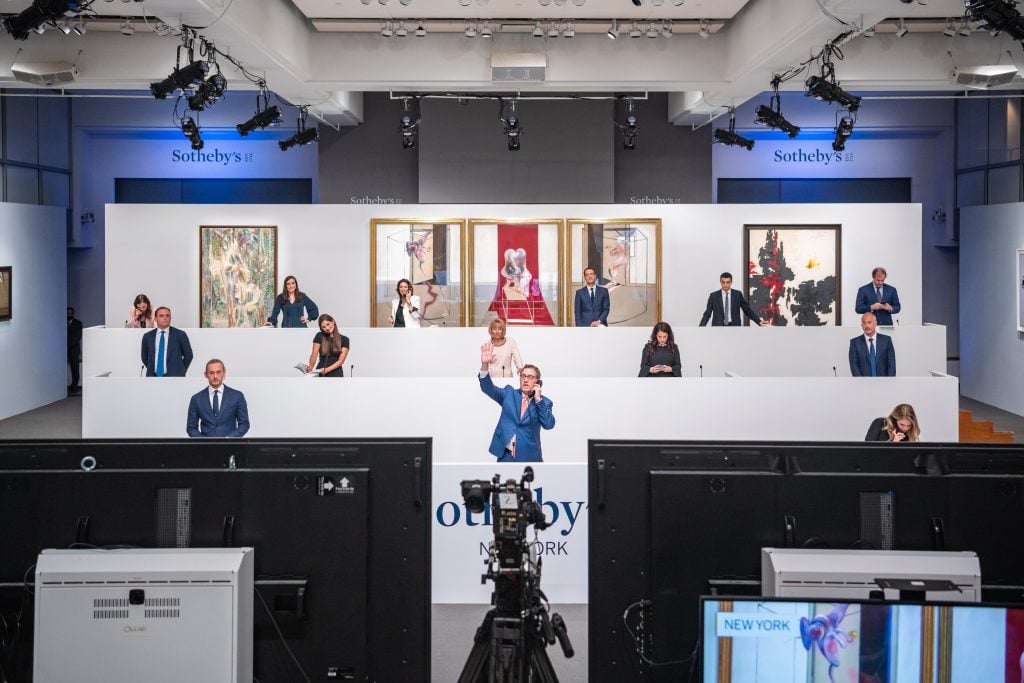
Sotheby’s salesroom in New York during its June 2020 evening sale. Photo: Sotheby’s.
On one hand, Sotheby’s could have won this honor by default. Phillips’s broadcast saw lots reopened after last-minute bids came through the system (although a rep for Phillips denied any lots were reopened and said there were no technical glitches). Meanwhile, the “relay” format of Christie’s “ONE” sale proved that having four auctioneers try to reconcile four different sets of bidders (not to mention their own egos over who gets to drop the hammer on each lot) in real time is, in fact, as awkward an idea in practice as it sounds on paper.
But as mentioned above, Sotheby’s presentation was legitimately well run and largely glitch-free, with Oliver Barker in London expertly handling the hybrid digital-analog central command post created by the house to funnel all bids to one place. For now, at least, it should be a model going forward.
Endurance Champions: Staff of Sotheby’s London

Sotheby’s location on New Bond Street in London. Photo by Claus Hoppe. Courtesy of Wikimedia Commons.
There’s no avoiding it: if your global sale lasts four and a half hours, some members of your organization are going to be working deep into the night in their part of the world. Since Sotheby’s 6:30 p.m. start time in New York meant an 11:30 p.m. start time in London, the house’s specialists and support staff were ultimately on call (literally, when it came to the phone bank), and on camera, until the bleary hour of 4 a.m. Here’s hoping that new one percent “overhead premium” the house starts charging August 1 at least meant they got to expense a car ride home.
